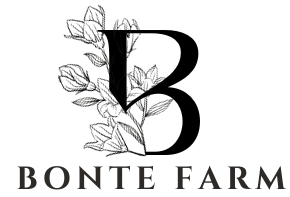Bonte Farm
Protea 'Thomas': A Regal Bloom for the Discerning Gardener
Protea 'Thomas': A Regal Bloom for the Discerning Gardener
Couldn't load pickup availability
Protea 'Thomas': A Grand Statement for Your Landscape
Protea 'Thomas' is a magnificent cultivar prized for its large, striking flower heads and vibrant coloration. This South African native brings a touch of regal elegance to gardens in suitable climates, attracting pollinators and adding a dramatic focal point to the landscape.
A Display of Royal Splendor:
- Spectacular Flowers: Protea 'Thomas' produces impressive, cup-shaped flower heads with vibrant pink or rose-red bracts surrounding a central cone. These captivating blooms appear primarily in spring and summer, creating a dazzling display that can last for several weeks.
- Attractive Foliage: The plant's attractive, leathery leaves, often tinged with red or bronze when young, provide year-round interest and serve as a beautiful backdrop to the showy flowers.
Botanical Characteristics:
- Scientific Name: Protea 'Thomas'
- Common Names: Thomas Protea, (Common names can vary regionally)
- Growth Habit: Evergreen shrub, typically upright and bushy.
- Foliage: Leathery, often lance-shaped, sometimes with a reddish or bronze tinge, especially when new.
- Mature Size: Typically reaches 6-8 feet (1.8-2.4 meters) in height and a similar spread, though size can vary depending on growing conditions and pruning.
- USDA Hardiness Zones: 9-11. This indicates it is best suited to warmer, frost-free climates.
Cultivation and Care:
- Sunlight: Requires full sun for optimal growth and abundant flowering. At least 6 hours of direct sunlight daily is recommended.
- Soil: Well-drained, acidic soil is crucial. Proteas are highly susceptible to root rot in waterlogged conditions. Sandy or loamy soils are preferred. Avoid heavy clay soils unless amended extensively.
- Water: Water regularly during the first year to establish a strong root system. Once established, Proteas are relatively drought-tolerant, but they benefit from occasional deep watering during dry periods, especially during flowering. Avoid overwatering.
- Fertilizer: Proteas generally do not require heavy fertilization. A light feeding with a phosphorus-rich fertilizer in early spring can be beneficial. Avoid fertilizers high in nitrogen, as this can promote excessive foliage growth at the expense of flowering.
- Temperature: Thrives in warm climates. Tolerates some heat but is not frost-tolerant.
- Pruning: Light pruning after flowering can help maintain shape and encourage bushier growth. Remove spent flower heads to promote further blooming and prevent seed development (if desired).
Landscape Use:
- Specimen Plant: Protea 'Thomas' makes a stunning specimen plant, adding a touch of regal elegance to any garden.
- Mixed Borders: It can be incorporated into mixed borders with other drought-tolerant, sun-loving plants that share similar soil requirements.
- Container Gardening: Proteas can also be grown successfully in containers, making them suitable for patios and balconies. Use a well-draining potting mix formulated for acid-loving plants.
- Focal Point: Due to its size and stunning blooms, 'Thomas' makes an excellent focal point in a garden.
Wildlife Attraction:
- Pollinators: The vibrant flowers attract a variety of pollinators, including bees, butterflies, and birds, contributing to a healthy garden ecosystem. Proteas are particularly attractive to nectar-feeding birds like sunbirds.
Pest and Disease Resistance:
- Generally resistant to most common pests and diseases when grown in appropriate conditions. Root rot can be a problem in poorly drained soils. Good air circulation is important to prevent fungal diseases.
Propagation:
- Proteas are typically propagated from seed or cuttings. Seed propagation can be challenging. Semi-hardwood cuttings taken in spring or summer are generally more successful.
Incorporating Protea 'Thomas' into Your Landscape:
- Planting Location: Choose a sunny location with well-drained, acidic soil. Consider the mature size of the plant when selecting a planting site.
- Companion Plants: Plant Protea 'Thomas' with other drought-tolerant, sun-loving plants that thrive in acidic soil, such as other Proteaceae members, Leucospermums, and certain fynbos species.
- Soil Amendment: Amend heavy clay soils with organic matter to improve drainage. Adding pine bark or other acidic organic matter can also be beneficial.
Relevant Keywords: Protea, Thomas Protea, South African shrub, evergreen shrub, pink flowers, red flowers, drought-tolerant plant, pollinator-friendly plant, bird-attracting plant, USDA zone 9, USDA zone 10, USDA zone 11, spring blooming shrub, summer blooming shrub, container gardening, focal point plant, Proteaceae family.
